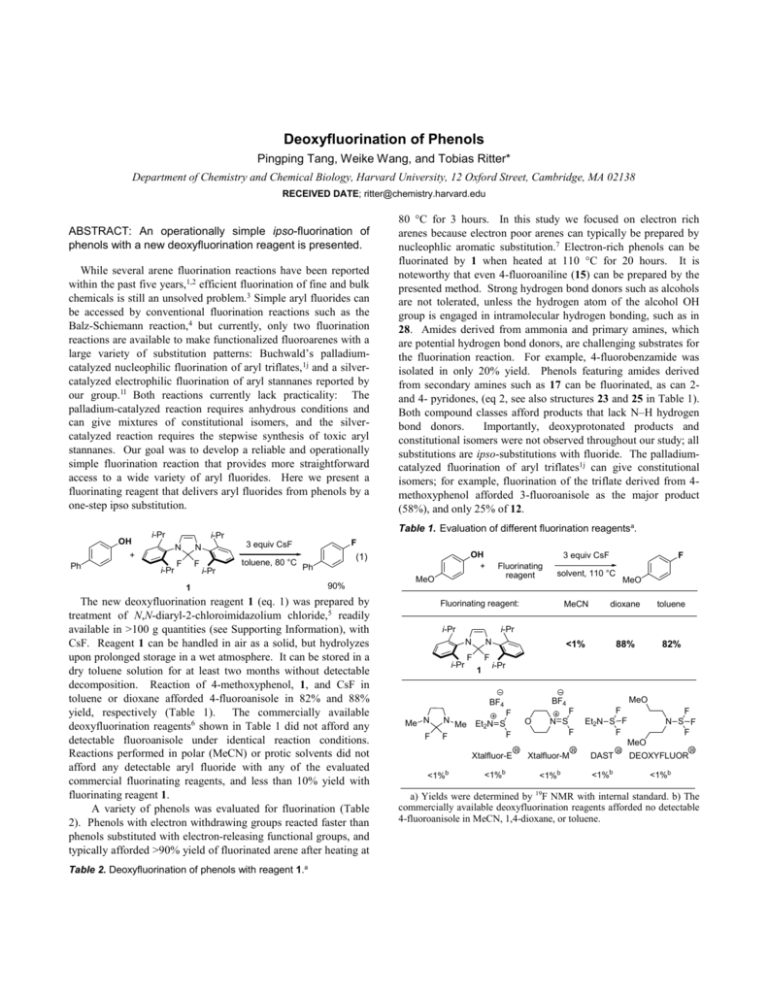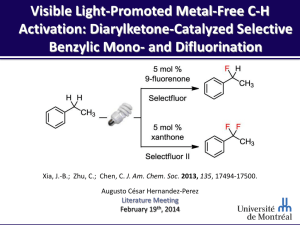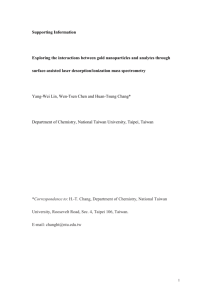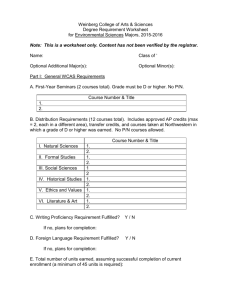Ritter_Deoxyfluorination
advertisement

Deoxyfluorination of Phenols Pingping Tang, Weike Wang, and Tobias Ritter* Department of Chemistry and Chemical Biology, Harvard University, 12 Oxford Street, Cambridge, MA 02138 RECEIVED DATE; ritter@chemistry.harvard.edu ABSTRACT: An operationally simple ipso-fluorination of phenols with a new deoxyfluorination reagent is presented. While several arene fluorination reactions have been reported within the past five years,1,2 efficient fluorination of fine and bulk chemicals is still an unsolved problem.3 Simple aryl fluorides can be accessed by conventional fluorination reactions such as the Balz-Schiemann reaction,4 but currently, only two fluorination reactions are available to make functionalized fluoroarenes with a large variety of substitution patterns: Buchwald’s palladiumcatalyzed nucleophilic fluorination of aryl triflates,1j and a silvercatalyzed electrophilic fluorination of aryl stannanes reported by our group.1l Both reactions currently lack practicality: The palladium-catalyzed reaction requires anhydrous conditions and can give mixtures of constitutional isomers, and the silvercatalyzed reaction requires the stepwise synthesis of toxic aryl stannanes. Our goal was to develop a reliable and operationally simple fluorination reaction that provides more straightforward access to a wide variety of aryl fluorides. Here we present a fluorinating reagent that delivers aryl fluorides from phenols by a one-step ipso substitution. OH i-Pr + Ph i-Pr Table 1. Evaluation of different fluorination reagentsa. i-Pr N N 3 equiv CsF F F toluene, 80 °C i-Pr 80 C for 3 hours. In this study we focused on electron rich arenes because electron poor arenes can typically be prepared by nucleophlic aromatic substitution.7 Electron-rich phenols can be fluorinated by 1 when heated at 110 C for 20 hours. It is noteworthy that even 4-fluoroaniline (15) can be prepared by the presented method. Strong hydrogen bond donors such as alcohols are not tolerated, unless the hydrogen atom of the alcohol OH group is engaged in intramolecular hydrogen bonding, such as in 28. Amides derived from ammonia and primary amines, which are potential hydrogen bond donors, are challenging substrates for the fluorination reaction. For example, 4-fluorobenzamide was isolated in only 20% yield. Phenols featuring amides derived from secondary amines such as 17 can be fluorinated, as can 2and 4- pyridones, (eq 2, see also structures 23 and 25 in Table 1). Both compound classes afford products that lack N–H hydrogen bond donors. Importantly, deoxyprotonated products and constitutional isomers were not observed throughout our study; all substitutions are ipso-substitutions with fluoride. The palladiumcatalyzed fluorination of aryl triflates1j can give constitutional isomers; for example, fluorination of the triflate derived from 4methoxyphenol afforded 3-fluoroanisole as the major product (58%), and only 25% of 12. F OH + (1) Ph 1 90% The new deoxyfluorination reagent 1 (eq. 1) was prepared by treatment of N,N-diaryl-2-chloroimidazolium chloride,5 readily available in >100 g quantities (see Supporting Information), with CsF. Reagent 1 can be handled in air as a solid, but hydrolyzes upon prolonged storage in a wet atmosphere. It can be stored in a dry toluene solution for at least two months without detectable decomposition. Reaction of 4-methoxyphenol, 1, and CsF in toluene or dioxane afforded 4-fluoroanisole in 82% and 88% yield, respectively (Table 1). The commercially available deoxyfluorination reagents6 shown in Table 1 did not afford any detectable fluoroanisole under identical reaction conditions. Reactions performed in polar (MeCN) or protic solvents did not afford any detectable aryl fluoride with any of the evaluated commercial fluorinating reagents, and less than 10% yield with fluorinating reagent 1. A variety of phenols was evaluated for fluorination (Table 2). Phenols with electron withdrawing groups reacted faster than phenols substituted with electron-releasing functional groups, and typically afforded >90% yield of fluorinated arene after heating at Table 2. Deoxyfluorination of phenols with reagent 1.a 3 equiv CsF Fluorinating reagent MeO Fluorinating reagent: i-Pr i-Pr N F F 1 MeCN dioxane toluene <1% 88% 82% i-Pr Xtalfluor-E <1%b MeO BF4 F F F N Me Et N S 2 F F <1%b MeO i-Pr N BF4 Me N F F solvent, 110 °C O N S F F N S F F Et2N S F F MeO R Xtalfluor-M <1%b R DAST <1%b R DEOXYFLUOR R <1%b a) Yields were determined by 19F NMR with internal standard. b) The commercially available deoxyfluorination reagents afforded no detectable 4-fluoroanisole in MeCN, 1,4-dioxane, or toluene. i-Pr OH + R i-Pr F F 1 O2N R toluene i-Pr F F F F3C H Ph OMe F O O O F 3 equiv CsF N F F F i-Pr N Ph H 2, 93% 3, 98%b 4, 95% 5, 95%b 6, 92%b 7, 82%b 8, 90% (80 °C, 3 h) (80 °C, 3 h) (80 °C, 3 h) (80 °C, 3 h) (80 °C, 3 h) (80 °C, 18 h) (80 °C, 18 h) F F F Cl F F Me MeO Br F F Me H2N Cl S 9, 91% (80 °C, 18 h) 10, 88%b 11, 88%b (80 °C, 18 h) (80 °C, 18 h) F F 12, 82%b (110 °C, 20 h) 13, 81%b 14, 87%b,c,d 15, 75%b,c (110 °C, 20 h) (110 °C, 20 h) (110 °C, 20 h) F Me2N O F 17, 91% 18, 86% 19, 88% (110 °C, 20 h) (110 °C, 20 h) (110 °C, 20 h) (110 °C, 20 h) c 20, 90% (110 °C, 20 h) N MeO F N N 21, 92% 22, 95% (110 °C, 20 h) (110 °C, 20 h) Me O O F N F 16, 74%b F F N N Bn NMe2 Bn N F F OH O F Me N H OEt O H F H F F 23, 90%b 24, 84%b 25, 50%b,c,e 26, 88% 27, 90% (80 °C, 18 h) (110 °C, 20 h) (110 °C, 20 h) (110 °C, 20 h) (110 °C, 20 h) O 28, 75% (110 °C, 20 h) OAc N 29, 95% (110 °C, 20 h) a) Reaction conditions: 1.2 equiv of 1, concentration = 0.1 M. Toluene was used as standard solvent due to its higher boiling point (111 C) compared to 1,4-dioxane (101 C). b) Yields were determined by 19F NMR with 1-fluoro-3-nitrobenzene as a standard. c) 1,4-dioxane was used as solvent. d) 20 mol% ZnPh2 was added;7 55% yield in the absence of ZnPh2. e) 20 mol% ZnPh2 was added; 25% yield in the absence of ZnPh2. i-Pr O HN + i-Pr i-Pr N N F F 1 F 3 equiv CsF toluene, 80 °C (2) N i-Pr 90% We propose that the mechanism for fluorination proceeds via a 2-phenoxy-imidazolium bifluoride salt such as 30, formed by condensation of a phenol with 1 (Scheme 1). Salt 30 was formed upon mixing 4-methoxyphenol and 1, and could be isolated in 91% yield. A hydrogen bond between one hydrogen atom of the imidazolium heterocycle and the bifluoride counteranion was identified in the crystal structure of 30 (C–F distance of C–H···F– H–F: 3.0 Å). We postulate that a similar hydrogen bond is also present in solution in apolar solvents: when the hexafluorophosphate salt 33 was treated with bifluoride, a shift of the 1H NMR resonance of the hydrogen atoms of the imidazolium heterocycle was observed from 7.56 ppm to 7.98 ppm (see Supporting Information). Bifluoride is a strong hydrogen bond acceptor.9 Hydrogen bonding could facilitate fluorination because it renders the uronium a better nucleofuge or because the bifluoride salts such as 30 exist as soluble tight ion pairs in apolar solvents, with close proximity of fluoride to the ipso-carbon. In agreement with both hypotheses, imidazolium salts 31 and 32, which lack the opportunity for similar hydrogen bonding, did not afford detectable aryl fluoride when heated. Likewise, exchange of the bifluoride for the less hydrogen bond-accepting counteranion PF6 lowered the reaction yield to 2%. Moreover, the commercially available deoxyfluorinating reagents shown in Table 1 lack the ability to form intermediates suitable for C(sp2)···F–H–F hydrogen bonding as found in 30, which may explain the difference in deoxyfluorinating reactivity between the known reagents and 1. Quantitative rate measurements, for example for a Hammett analysis with different substituents in the para position of the phenol, were not obtained due to the fact that the reaction mixture is heterogeneous. The heterogeneous mixture may also explain the difference in yield of fluorination when fluorination is performed with 30 isolated (67%, reaction incomplete), rather than formed in situ in the presence of excess CsF (82%). Scheme 1. Studies of Hydrogen bonding F H F H OH 1 toluene 23 °C MeO H Ar N N Ar O OMe 30, 91% H H Ar N X- ray of 30 (2) HF2 N Ar toluene-d8, 110 °C OAr' F 3 equiv CsF MeO 30 (5) 67% (6) HF2 Cl Cl Ar N N Ar F 3 equiv CsF toluene-d8, 110 °C (3) (4) (7) MeO OAr' 31 <1% HF2 F 3 equiv CsF Ar N N Ar toluene-d8, 110 °C MeO OAr' <1% 32 H H PF6 F 3 equiv CsF Ar N N Ar toluene-d8, 110 °C MeO OAr' 33 2% Ar = 2,6-diisopropylphenyl, Ar’= 4-methoxylphenyl In conclusion we have developed a practical deoxyfluorination of phenols that can be used conveniently from milligram to multigram scale. Whereas in conventional nucleophilic fluorination chemistry hydrogen bonding is undesirable because it reduces the nucleophilicity of fluoride, hydrogen bonding appears to be crucial for the fluorination reaction presented here. A disadvantage of the transformation is the generation of a stoichiometric amount of waste, the urea byproduct. However, the deoxyfluorination proceeds in one step from phenols. Ultimately, a fluorination reaction that could combine the operational simplicity of the transformation presented here, the catalysis approach of the Buchwald fluorination, and the ability to fluorinate complex molecules late stage as accomplished by the silver-catalyzed fluorination would significantly advance the field of fluorination. Acknowledgements: We thank Dr. Shao-Liang Zheng for his help with X-ray data collection and structure determination. This work was supported by NSF (CHE-0952753) and NIH-NIGMS (GM088237). Supporting Information Available: Experimental procedures and spectroscopic data for all new compounds. This material is available free of charge via the Internet at http://pubs.acs.org. REFERENCES (1) For transition-metal-mediated C–F bond formation, see: (a) Hull, K. L.; Anani, W. Q.; Sanford, M. S. J. Am. Chem. Soc. 2006, 128, 7134. (b) (8) (9) Akana, J. A.; Bhattacharyya, K. X.; Müller, P.; Sadighi, J. P. J. Am. Chem. Soc. 2007, 129, 7736. (c) Kaspi, A. W.; Yahav-Levi, A.; Goldberg, I.; Vigalok, A. Inorg. Chem. 2008, 47, 5. (d) Furuya, T.; Kaiser, H. M.; Ritter, T. Angew. Chem. Int. Ed. 2008, 47, 5993. (e) Furuya, T.; Ritter, T. J. Am. Chem. Soc. 2008, 130, 10060. (f) Furuya, T.; Strom, A. E.; Ritter, T. J. Am. Chem. Soc. 2009, 131, 1662. (g) Ball, N. D.; Sanford, M. S. J. Am. Chem. Soc. 2009, 131, 3796. (h) Wang, X.; Mei, T. S.; Yu, J. Q. J. Am. Chem. Soc. 2009, 131, 7520. (i) Furuya, T.; Ritter, T. Org. Lett. 2009, 11, 2860. (j) Watson, D. A.; Su, M.; Teverovskiy, G.; Zhang, Y.; García-Fortanet, J.; Kinzel, T.; Buchwald, S. L. Science 2009, 325, 1661. (k) Furuya, T.; Benitez, D.; Tkatchouk, E.; Strom, A. E.; Tang, P.; Goddard III, W. A.; Ritter, T. J. Am. Chem. Soc. 2010, 132, 3793. (l) Tang, P.; Furuya, T,; Ritter, T. J. Am. Chem. Soc. 2010, 132, 12150. (m) Tang, P.; Ritter, T. Tetrahedron 2011, 67, 4449. For other recent arene fluorination reactions, see: (a) Sun, H.; DiMagno, S. G. Angew. Chem. Int. Ed. 2006, 45, 2720. (b) Yamada, S.; Gavryushin, A.; Knochel, P. Angew. Chem. Int. Ed. 2010, 49, 2215. (c) Anbarasan, P.; Neumann, H.; Beller, M. Angew. Chem. Int. Ed. 2010, 49, 2219. Furuya, T.; Kamlet, A. S.; Ritter, T. Nature 2011, 473, 470. (a) O’Hagan, D. Chem. Soc. Rev. 2008, 37, 308. (b) Furuya, T.; Klein, J. E. M. N.; Ritter, T. Synthesis 2010, 11, 1804. Mendoza-Espinosa, D.; Donnadieu, B.; Bertrand, G. J. Am. Chem. Soc. 2010, 132, 7264. (a) Middleton, W. J. J. Org. Chem. 1975, 40, 574. (b) Lal, G. S.; Pez, G. P.; Pesaresi, R. J.; Prozonic F. M. Chem. Commun. 1999, 2, 215. (c) Hayashi, H.; Sonoda, H.; Fukumura, K.; Nagata, T. Chem. Commun. 2002, 1618. (d) Beaulieu, F.; Beauregard, L. P.; Courchesne, G.; Couturier, M.; LaFlamme, F.; L’Heureux, A. Org. Lett. 2009, 11, 5050. For selected nucleophilic aromatic fluorination reactions, see: (a) Bunnett, J. F.; Zahler, R. E. Chem. Review. 1951, 49, 273. (b) Adams, D. J.; Clark, J. H. Chem. Soc. Rev. 1999, 28, 225. (c) Kuduk, S. D.; DiPardo, R. M.; Bock, M. G. Org. Lett. 2005, 7, 577. (d) Sun, H.; DiMagno, S. G. J. Am. Chem. Soc. 2005, 127, 2050. The role of Ph2Zn has not yet been established. Kollman, P. A.; Allen, L. C. J. Am. Chem. Soc. 1970, 92, 6101. TOC






